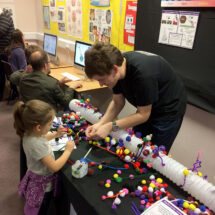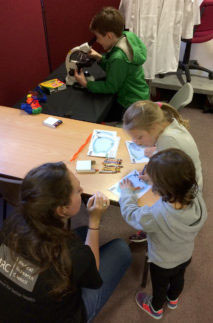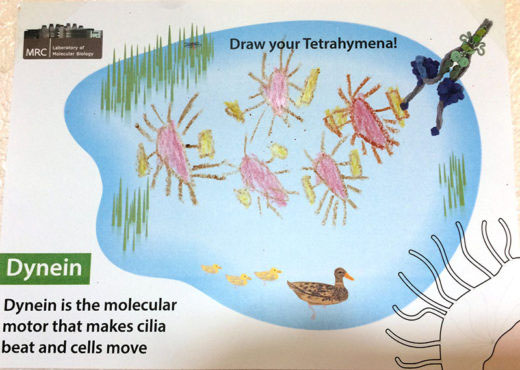 Hundreds of visitors recently discovered how tiny machines organise the insides of our cells at the LMB ‘Mighty Molecular Motors’ exhibit during the Big Biology Day at Hills Road Sixth Form College, Cambridge.
Hundreds of visitors recently discovered how tiny machines organise the insides of our cells at the LMB ‘Mighty Molecular Motors’ exhibit during the Big Biology Day at Hills Road Sixth Form College, Cambridge.
The exhibit was created by Andrew Carter’s group in the LMB’s Structural Studies Division. They are investigating the structure and mechanism of the large molecular motor, dynein, which helps to move and organise the contents of cells. Dynein moves cargo ~200 times it’s mass along microtubule ‘train tracks’ in the cell. Dynein is also needed to power the beating of cilia, tiny hair-like structures found on the surface of some cells. Defects in dynein are linked to developmental disorders and neurodegeneration, and dynein is hijacked by some viruses to infect our cells.
Big Biology Day visitors saw the molecular motors in action as they watched Tetrahymena move around under the microscope using dynein-powered cilia. Children were invited to draw their own ‘pond life’ picture, capturing what they saw under the microscope.
 Structural biologists visualise the molecular machines they are interested in by creating molecular models, both using computer programmes and making physical models. Visitors had a chance to make their own dynein models using pipe cleaners and pompoms, and to view the molecular structure of dynein using the molecular graphics programme, pymol. The pompom and pipe-cleaner model-making proved very popular and over 150 colourful dynein models were made during the day.
Structural biologists visualise the molecular machines they are interested in by creating molecular models, both using computer programmes and making physical models. Visitors had a chance to make their own dynein models using pipe cleaners and pompoms, and to view the molecular structure of dynein using the molecular graphics programme, pymol. The pompom and pipe-cleaner model-making proved very popular and over 150 colourful dynein models were made during the day.
Helen (PhD student in Andrew’s lab) said: “It was great to talk to the public about our favourite molecular motor. Some children were amazed to see the tiny Tetrahymena appear out of pond water and others enjoyed making and exploring our models of dynein. It gave me a new perspective to our work in the lab and I’m looking forward to next time!”
There will be another chance for people to try their hand at making a dynein model and find out about Andrew’s research at the LMB Open Day on Saturday 17 June 2017. The LMB will open it’s doors to visitors, who will be able to meet LMB scientists, see our world-class laboratories and facilities, learn about our cutting-edge research and take part in a number of family-friendly hands-on activities.

Further references
Big Biology Day Facebook page
Andrew’s group page
Public Engagement at the LMB